
Photo by HamZa NOUASRIA on Unsplash
Introduction:
Since its emergence in late 2019, the novel coronavirus, SARS-CoV-2, has rapidly spread across the world, resulting in the COVID-19 pandemic. It is essential to comprehend the scientific aspects of how this virus spreads and infects people in order to create efficient public health measures and strategies to contain its transmission. This article will explore the complex mechanisms of COVID-19 transmission and infection, providing insight into the main factors that contribute to its spread.
1. Transmission Routes:
COVID-19 primarily spreads through respiratory droplets that are produced when an infected person coughs, sneezes, or talks. These droplets can land in the mouths or noses of people nearby, leading to infection. Additionally, the virus can also spread by touching surfaces contaminated with the virus and then touching the face, although this is considered to be less common than respiratory transmission.
2. Airborne Transmission:
Recent evidence indicates that SARS-CoV-2 can also be transmitted through aerosols, which are smaller respiratory droplets that can stay suspended in the air for longer periods. This type of transmission is especially worrying in indoor environments with inadequate ventilation, as aerosols can build up and heighten the likelihood of infection, particularly in crowded areas.
3. Viral Shedding and Infectiousness:
Individuals who are infected can spread the virus and be contagious even before they show symptoms, which is known as pre-symptomatic transmission. Furthermore, some individuals may never experience symptoms but can still transmit the virus to others, making asymptomatic transmission a major obstacle in controlling the spread of COVID-19.
4. Factors Influencing Transmission:
There are several factors that can affect the spread of SARS-CoV-2, including being in close contact with infected individuals, being in crowded environments, having poor ventilation, and engaging in behaviors such as not wearing masks or practicing proper hand hygiene. Super-spreader events, where one infected person spreads the virus to a large group of people, have played a major role in causing community outbreaks.
5. Viral Replication and Pathogenesis:
Once the virus enters the body, it attaches to cells in the respiratory tract, specifically cells that line the nose and throat. It does this by using a spike protein on its surface to bind to receptors on the cell surface. The virus then enters the cell, takes control of its machinery to reproduce, and spreads to nearby cells. This results in the typical symptoms of COVID-19, including fever, cough, and difficulty breathing.
6. Host Immune Response:
The immune system of the body plays a vital role in combating the virus and eliminating the infection. However, in certain instances, an exaggerated immune reaction can result in excessive inflammation and harm to tissues, which can worsen the severity of COVID-19. It is crucial to comprehend the interaction between viral reproduction and the immune response of the host in order to create successful treatments and vaccines.
7. Variants and Evolution:
As the virus spreads and reproduces, it can develop mutations, resulting in new variants with varying characteristics. Certain variants may be more easily transmitted, more severe, or less responsive to vaccines or treatments, making it difficult to control the pandemic. It is crucial to monitor the appearance and spread of these variants in order to adjust public health measures accordingly.
8. Mitigation Strategies:
To prevent the spread of COVID-19, it is recommended to implement a combination of public health measures. These include wearing masks, maintaining physical distance, avoiding crowded indoor areas, improving ventilation, practicing hand hygiene, and getting vaccinated. These measures work together to decrease the likelihood of transmission and safeguard individuals and communities from infection.
Conclusion:
Understanding the scientific principles behind the transmission and infection of COVID-19 is crucial in developing successful strategies to manage the pandemic and safeguard public health. By unraveling the complex processes of viral spread, replication, and the body's immune response, scientists and public health professionals can create evidence-based interventions to minimize the virus's impact on society. Through ongoing research and cooperation, we can overcome the obstacles presented by COVID-19 and emerge stronger and more resilient in the face of future pandemics.
